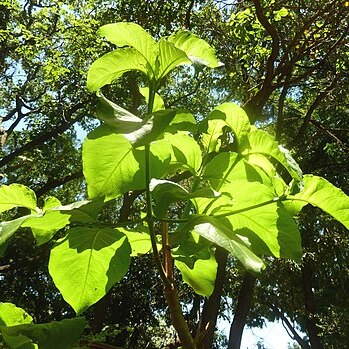A shrub or small tree. It has many stems and grows 4 m high. The bark is smooth and grey. The leaves are broadly sword shaped. They are 18 cm long by 7 cm wide. They are arranged opposite one another. There are many flowers on branched stalks. The flowers are greenish tubes. The fruit are round and about 3 cm across. They have a ring at the top. They are green but turn yellow-brown when ripe. There are about 5 seeds. The fruit are edible.
Inflorescences often appear before the leaves are fully expanded, sparsely pubescent to pubescent, 5–13-flowered; main peduncle up to 2.5 mm long; pedicels about 2 mm long, save those of central flower of inflorescence which may be longer.
Shrub or small tree, 0.8–5 m tall, often multi-stemmed and sometimes with a spreading crown; stems slender, glabrous, with wine-red bark, smooth when young but soon becoming powdery.
Corolla obtuse to slightly acuminate in bud; greenish-cream, glabrous; tube c. 4 mm long; lobes 2.5–3.5 mm long, acuminate.
Calyx tube c. 1 mm long, pubescent or glabrous; lobes 1.2–1.8 mm long, narrowly oblong, usually glabrous.
Fruits green to brownish, 1.8–2 cm diameter, subglobose; pyrenes 4–5, each c. 20 mm long.
Pollen presenter yellow, 1.2 mm long, cylindrical.
Style 5–6 mm long.


